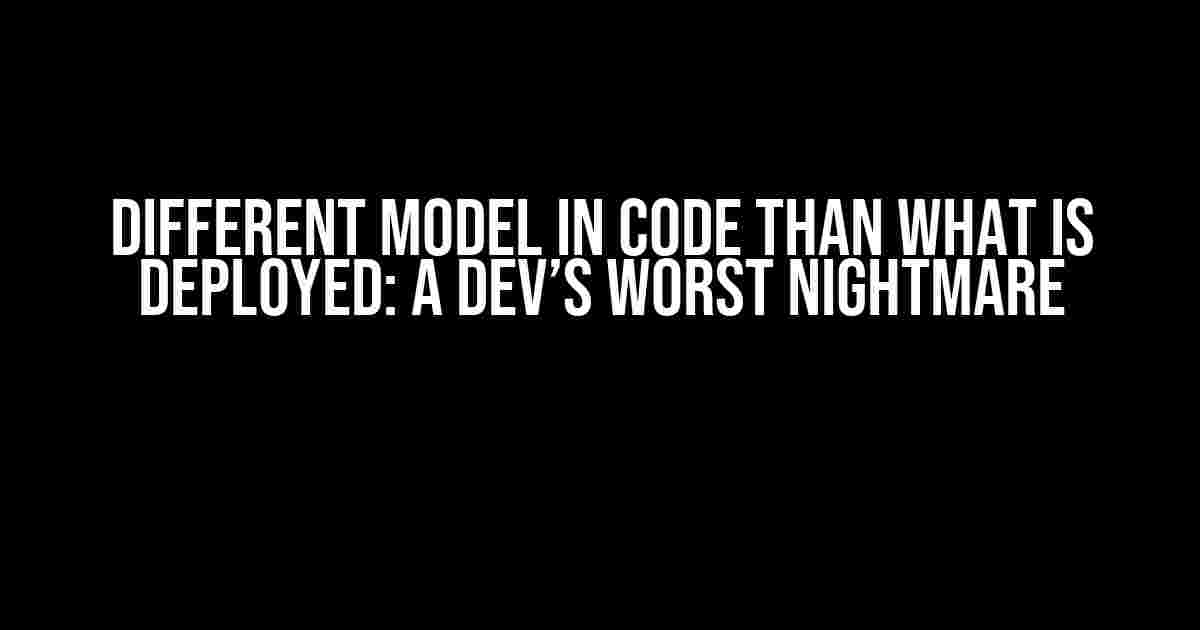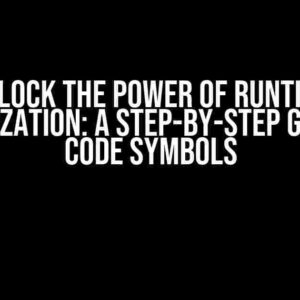Ever been in a situation where you’re scratching your head, wondering why your model is producing drastically different results in production compared to what you saw during development? You’re not alone! Many developers have fallen victim to the infamous “different model in code than what is deployed” syndrome.
The Problem: Model Drift and Versioning
In the world of machine learning, model drift and versioning can be a significant issue. Model drift occurs when the underlying data distribution changes over time, rendering your model less effective. Versioning, on the other hand, refers to the process of keeping track of changes to your model and ensuring that the correct version is deployed.
When these two issues combine, it can lead to a situation where the model in your code is significantly different from the one deployed in production. This can result in incorrect predictions, decreased accuracy, and even financial losses.
Why It Happens
There are several reasons why this discrepancy might occur:
- Manual Model Updates: Manual updates to the model can lead to differences between the code and deployed versions. This is especially true when working in a team environment, where multiple developers might be making changes to the model.
- Version Control Issues: Inadequate version control practices can result in different versions of the model being deployed. This can happen when developers are working on different branches or revisions of the code.
- Data Changes: Changes to the underlying data or data distribution can cause the model to drift, leading to differences between the code and deployed versions.
- Hyperparameter Tuning: Hyperparameter tuning can also lead to differences between the code and deployed versions. This is because hyperparameters are often tuned for specific datasets or environments.
Diagnosing the Issue
So, how do you diagnose this issue? Here are some steps to follow:
- Check the Model Version: Verify that the model version in your code matches the one deployed in production. You can do this by checking the model’s metadata or by using version control systems like Git.
- Compare Model Parameters: Compare the model parameters in your code with those in the deployed version. This can help you identify any differences in hyperparameters, architecture, or other model components.
- Analyze Data Distributions: Analyze the data distributions used to train the model in your code and compare them with the data distributions used in production. This can help you identify any data drift or changes that might be affecting the model’s performance.
- Re-run Training: Re-run the training process with the same data and hyperparameters used in production. This can help you identify any differences in the training process or environment.
Solutions and Best Practices
Now that we’ve diagnosed the issue, let’s talk about some solutions and best practices to prevent this problem from occurring in the first place:
Version Control and Model Management
Implementing proper version control and model management practices can help you keep track of changes to your model and ensure that the correct version is deployed.
# Example of using Git to track model changes git init git add model.py git commit -m "Initial model version"
Use tools like Git, TensorFlow’s Model Garden, or AWS SageMaker’s Model Registry to manage your model versions and keep track of changes.
Data Versioning and Drift Detection
Data versioning and drift detection can help you identify changes to the underlying data distribution and adapt your model accordingly.
# Example of using Data Version Control (DVC) to track data changes dvc init dvc add data.csv dvc commit -m "Initial data version"
Use tools like Data Version Control (DVC), Apache Spark’s MLlib, or AWS Lake Formation to track data changes and detect drift.
Automated Testing and Deployment
Automated testing and deployment can help you ensure that the correct model version is deployed and that it’s functioning as expected.
# Example of using pytest to test the model
import pytest
from model import MyModel
def test_model_accuracy():
model = MyModel()
accuracy = model.evaluate(test_data)
assert accuracy > 0.9
Use tools like pytest, PyCharm’s Built-in Testing, or AWS CodePipeline to automate testing and deployment.
Collaboration and Communication
Finally, ensure that all team members are aware of the model changes and are on the same page. This can be achieved through regular meetings, documentation, and communication.
| Team Member | Role | Responsibility |
|---|---|---|
| Dev 1 | Model Developer | Develop and test the model |
| Dev 2 | Data Engineer | Prepare and manage data |
| Manager | Project Manager | Oversee project development and deployment |
Conclusion
In conclusion, having a different model in code than what is deployed can be a nightmare for developers. However, by following the steps outlined in this article, you can diagnose and prevent this issue from occurring. Remember to implement proper version control and model management practices, data versioning and drift detection, automated testing and deployment, and collaboration and communication. With these best practices in place, you can ensure that your model is accurate, reliable, and effective in production.
So, go ahead and give your model the deployment it deserves. Happy coding!
Frequently Asked Questions
Got questions about differences in code and deployment models? We’ve got answers!
What are the consequences of having a different model in code than what is deployed?
Having a different model in code than what is deployed can lead to inconsistencies, errors, and even security breaches. It can also make it difficult to troubleshoot issues, leading to wasted time and resources.
Why do differences in code and deployment models occur?
Differences can occur due to various reasons such as manual errors, miscommunication, or inadequate testing. It can also happen when changes are made to the code without updating the deployment model or vice versa.
How can I avoid having different models in code and deployment?
To avoid discrepancies, it’s essential to maintain a single source of truth, ensure consistent communication among team members, and automate testing and deployment processes where possible. Regularly review and update both code and deployment models to ensure they are in sync.
What are some best practices to ensure consistency between code and deployment models?
Best practices include using version control systems, implementing continuous integration and deployment (CI/CD) pipelines, and conducting regular audits to identify and address any discrepancies. Additionally, ensure that all stakeholders have access to the same information and are on the same page.
What are the benefits of having consistent code and deployment models?
Having consistent models ensures reliability, reduces errors, and improves overall system performance. It also enhances collaboration, reduces maintenance costs, and enables faster troubleshooting and debugging.


